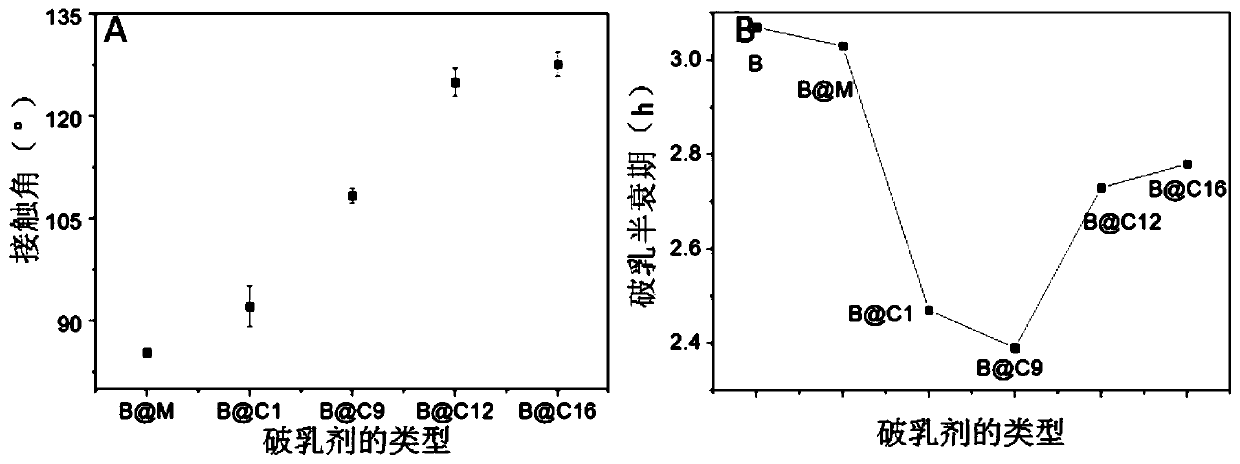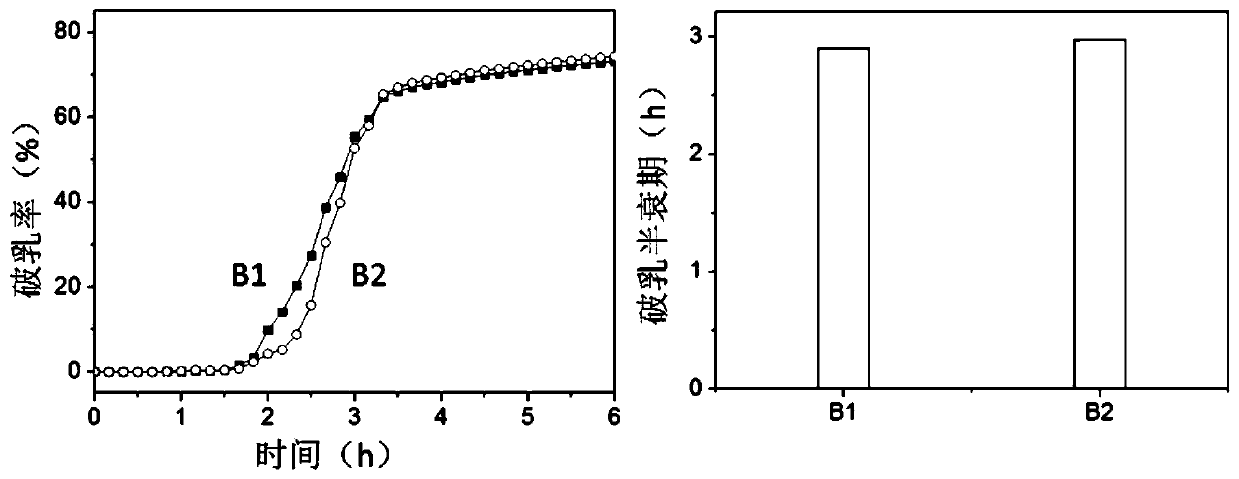A method for enhancing demulsification performance of demulsifier
A technology of demulsification and demulsification, which is applied in the field of environmental microorganisms to achieve the effects of effective regulation, speeding up demulsification rate and improving dehydration quality
- Summary
- Abstract
- Description
- Claims
- Application Information
AI Technical Summary
Problems solved by technology
Method used
Image
Examples
preparation example Construction
[0035] Preparation of magnetic nanoparticles: weigh 5.56g FeSO 4 ·7H 2 O and 11.6 g FeCl 3 ·6H 2 O in N2 Dissolve in 350 mL of ultrapure water at 500 rpm under stripping; quickly add 20 mL of concentrated ammonia water (25%), and stir for 6 hours. Wash three times with deionized water, and recover Fe by magnet 3 o 4 magnetic nanoparticles. will get Fe 3 o 4 The magnetic nanoparticles were dispersed into the mixed solution (120mL ethanol, 30mL ultrapure water, 2mL ammonia water), and ultrasonicated for 5min. Add 4mL tetraethyl orthosilicate to the above solution, then ultrasonicate for 5min, mechanically stir for 6h (500rpm); collect in an external magnetic field, and obtain silica-modified magnetic nanoparticles Fe 3 o 4 @SiO 2 .
[0036] Modified synthesis of nanoparticles with different hydrophobicity and charge series: the Fe 3 o 4 @SiO 2 Disperse in 100mL of toluene, add 10mL of silylating reagents with different carbon chain lengths, ultrasonicate for 5min, ...
Embodiment 1
[0040] Depend on figure 1 It can be seen that the surface hydrophobicity of demulsifiers can be adjusted by using magnetic nanoparticles, and it is found that the demulsification rate of demulsifiers modified by different degrees of hydrophobicity is small, and the demulsification rate is quite different. The demulsification rate of the magnetic-responsive demulsifiers increased first and then decreased with the hydrophobicity. When the contact angle of the bacteria to water was in the range of 95-115°, the demulsification rate of the bacteria was improved; the demulsification rate modified by M@C9 The contact angle of milk bacteria was 105°, and the demulsification rate was the fastest, which was accelerated by about 1.0h. The improvement of demulsification rate indicates that the volume of emulsion that can be processed in the same time increases, which is of great significance for increasing the demulsification efficiency and reducing the cost of demulsification.
Embodiment 2
[0042] Depend on figure 2 It can be seen that the surface charge of demulsifiers can be regulated by using magnetic nanoparticles, and it is found that the demulsification rate and demulsification rate of demulsifiers modified by different charges are quite different. When the Zeta potential of the magnetic response demulsifier is lower than -25mV, the demulsification rate and demulsification rate of the magnetic response demulsifier are higher; when the Zeta potential of the magnetic response demulsifier exceeds -25mV, the demulsification rate and demulsification The rate decreased significantly, among which the demulsification rate decreased by 15%, and the demulsification rate slowed down by 1.0h. Therefore, for magnetic-responsive demulsifiers, when the charging range suitable for demulsification is -30~-20mV, at this time, the demulsification rate is increased by 0.5h relative to the bacteria under the premise of maintaining a high demulsification rate.
PUM
 Login to View More
Login to View More Abstract
Description
Claims
Application Information
 Login to View More
Login to View More - R&D
- Intellectual Property
- Life Sciences
- Materials
- Tech Scout
- Unparalleled Data Quality
- Higher Quality Content
- 60% Fewer Hallucinations
Browse by: Latest US Patents, China's latest patents, Technical Efficacy Thesaurus, Application Domain, Technology Topic, Popular Technical Reports.
© 2025 PatSnap. All rights reserved.Legal|Privacy policy|Modern Slavery Act Transparency Statement|Sitemap|About US| Contact US: help@patsnap.com



